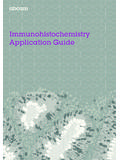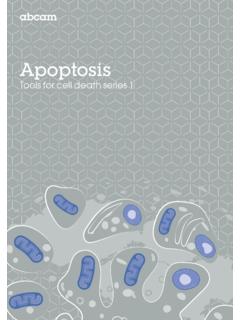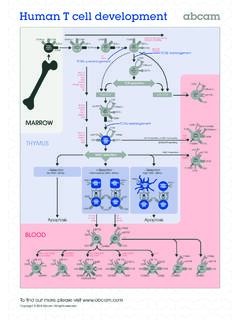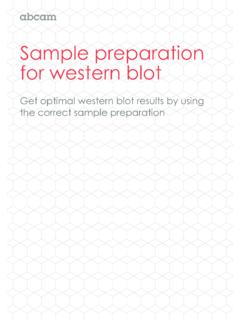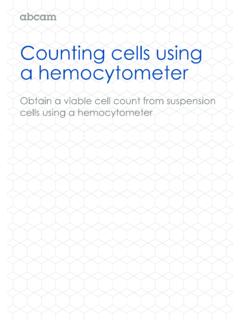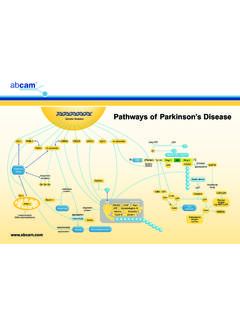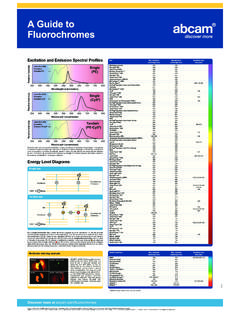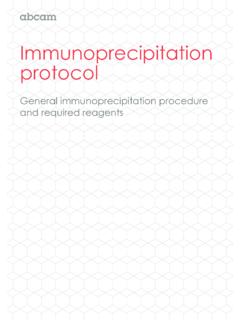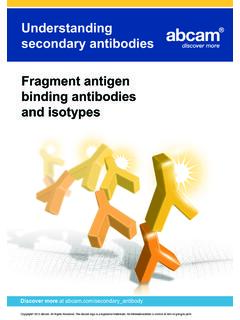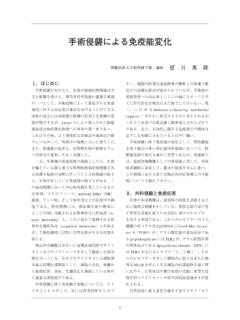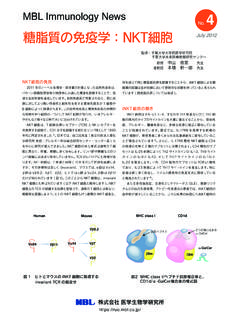Transcription of Guide to Human CD antigens
1 Discover moreat to Human CD antigensAbout AbcamAbcam is a provider of protein research tools and services, with an unrivaled rangeof products and expert technical support, enabling scientists to analyze living cellsat the molecular level and improving the understanding of health and disease. Abcam is committed to providing scientists with an extensive choice of reagents andtools, with the most comprehensive, honest and up-to-date datasheets and customerreviews, fast delivery and helpful customer service & technical support. Thecompany s catalog of products includes primary and secondary antibodies, proteins,peptides, lysates, biochemicals, immunoassays and other kits. To find out more, please visit note on CD antigensThe cluster of differentiation (CD) nomenclature system was conceived to classify antigensfound on the surface of leukocytes.
2 Initially, surface antigens were named after the monoclonal antibodies that bound to them. As there were often multiple monoclonal antibodiesraised against each antigen by different labs, the need arose to adopt a consistent nomenclature. The current system was adopted in 1982, during the 1st International Workshopand Conference on Human Leukocyte Differentiation antigens (HLDA) in the current naming system, antigens that are well characterized are assigned an arbitrary number ( CD1, CD2 etc) whereas molecules that are recognised by just onemonoclonal antibody are given the provisional designation CDw . Physiologically, CD antigens do not belong in any particular class of molecules, with their functions ranging fromcell surface receptions to adhesion molecules. Although initially used for just Human leukocytes, the CD molecule naming convention has now been expanded to cover both otherspecies ( mouse) as well as other cell types.
3 Human CD antigens are currently numbered up to presence or absence of a specific antigen from the surface of particular cell population is denoted with + or - respectively. Varying cellular expression levels are alsomarked as hior low, for example central memory T cells are CD62 Lhiwhereas effectormemory T cells are CD62 Llow. Monitoring the expression profiles of different CDantigens has permitted the identification, isolation and phenotyping of cell typesaccording to their function in various immune processes. AbbreviationsADCC Antibody-dependent cell-mediated cytotoxicityAPC AllophycocyaninFITC Fluorescein IsothiocyanateNFkB NF-kappa-BOC 515 Orange Cytognos 515 PBMCs Peripheral blood mononuclear cellsPerCP Perinidin Chlorophyll ProteinPE PhycoerythrinDisclaimersOC 515 is a trademark of Cytognos is a trademark of Biotium, IncCy is a trademark of GE healthcareDiscover moreat *: against pan-CD3.
4 Featured productPolyclonalUnconjugatedCF 405 MOC 515 FITCPEAPCPE/Cy 5 PerCPAPC/Cy 7PE/Cy 7 BiotinImmunoassay kitsProteinOther fluorochromeTarget Alternative Cellular Functionsname name expression CD1a - Cortical thymocytes, Langerhans cells, dendritic cells and Non-peptide antigen presentation to T-cell receptors on NKT cells, marks certain T-cell leukemias.
5 T-cells at the short cortical thymic stage of differentiation. CD1b - Cortical thymocytes, Langerhans cells and dendritic cells. Non peptide antigen presentation to T-cell receptors on NKT cells. CD1c - Cortical thymocytes, Langerhans cells, dendritic cells and Non peptide antigen presentation to T-cell receptors on NKT cells. B-cell R3G1 Intestinal epithelial cells, B-cell subsets, cortical thymocytes, Non peptide antigen presentation to T-cell receptors on NKT cells.
6 Dendritic cells and certain T-cell R2G1 Cortical thymocytes, Langerhans cells, dendritic cells and Non peptide antigen presentation. certain T-cell SRBC, Erythrocyte receptor, LFA-2, Thymocytes, natural killer cells, T- and B-cells.
7 Adhesion between T-cells and other cell types and T-cell activation. LFA-3 receptor, Rosette receptorCD3d T3D, OKT3 Mature T-cells and thymocytes. T-cell activation signaling and regulation of TCR expression. * * * * * * * * * * * * * CD3e T3E, TCRE Mature T-cells and thymocytes. T-cell activation signaling and regulation of TCR expression.
8 CD3g T3G Mature T-cells and thymocytes. T-cell activation signaling and regulation of TCR expression. CD4 - Thymocyte subsets, T-helper cells, regulatory T-cells, T-cell activation, thymic differentiation and receptor for HIV. monocytes and LEU1 Thymocytes, T- and B-cell subsets and B-cell chronic Regulates T-cell: B-cell interactions.
9 Interacts with CD72. lymphocytic leukemia OX52, T12, TP120 Thymocytes, T- and B-cell subsets and neuron subsets. Thymocyte development, a potential market of T-cell activation. CD7 LEU 9, GP40, TP41 Thymocytes, T-cells, natural killer cells and pluripotent T-cell costimulation. Interacts with SECTM1. hematopoietic stem MAL Thymocyte subsets, cytotoxic T-cells, natural killer cells and Co-receptor for MHC class 1 molecules.
10 Dendritic cells CD8B1 Thymocyte subsets and cytotoxic T-cells. Co-receptor for MHC class 1 molecules. CD9 P24, 5H9 antigen , MIC3, Platelets, pre-B-cells, eosinophils, basophils, activated T-cells, Cell adhesion and migration, platelet activation and aggregation.
